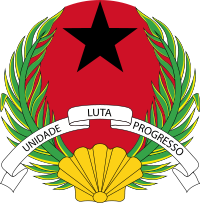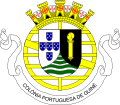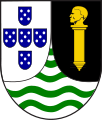- Emblem of Guinea-Bissau
-
National emblem of Guinea-Bissau 
Details Armiger Guinea-Bissau Adopted 1973 The national emblem of Guinea-Bissau was adopted shortly after independence from Portugal in 1973. Featured prominently is a black star, that is part of traditional Pan-African symbolism, and is often referred to as the Black star of Africa. A seashell at the bottom unites two symmetrical olive branches. The sea shell is symbolism for the location of the country on the West coast of Africa. The red banner contains the national motto of the nation: that translates to English as "Unity, Struggle, Progress".
Historical coat of arms
-
Coat of arms of Portuguese Guinea between May 8, 1935 - June 11, 1951.
Coats of arms and emblems of Africa Sovereign
states- Algeria
- Angola
- Benin
- Botswana
- Burkina Faso
- Burundi
- Cameroon
- Cape Verde
- Central African Republic
- Chad
- Comoros
- Democratic Republic of the Congo
- Republic of the Congo
- Côte d'Ivoire (Ivory Coast)
- Djibouti
- Egypt
- Equatorial Guinea
- Eritrea
- Ethiopia
- Gabon
- The Gambia
- Ghana
- Guinea
- Guinea-Bissau
- Kenya
- Lesotho
- Liberia
- Libya
- Madagascar
- Malawi
- Mali
- Mauritania
- Mauritius
- Morocco
- Mozambique
- Namibia
- Niger
- Nigeria
- Rwanda
- São Tomé and Príncipe
- Senegal
- Seychelles
- Sierra Leone
- Somalia
- South Africa
- South Sudan
- Sudan
- Swaziland
- Tanzania
- Togo
- Tunisia
- Uganda
- Zambia
- Zimbabwe
States with limited
recognition- Sahrawi Arab Democratic Republic
- Somaliland
Dependencies and
other territories- Canary Islands / Ceuta / Melilla / Plazas de soberanía (Spain)
- Madeira (Portugal)
- Mayotte / Réunion (France)
- Saint Helena / Ascension Island / Tristan da Cunha (United Kingdom)
- Western Sahara
Categories:- National symbols of Guinea-Bissau
- National emblems
- Guinea-Bissau stubs
- Heraldry stubs
-
Wikimedia Foundation. 2010.



